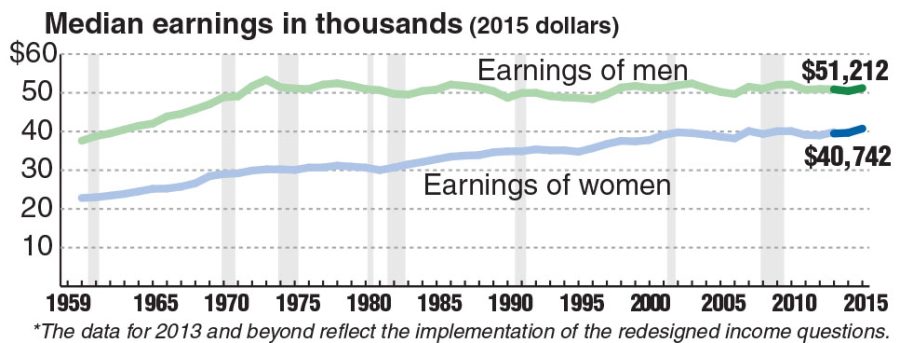Gender pay gap is misleading, not sexist
Chart showing female to male earnings from full-time, year-round workers. TNS 2016
March 6, 2023
The gender wage gap is not what it’s made out to be. At first glance, it appears to be an obstacle hindering women in the workplace. However, a closer look at the issue reveals that the argument that women get paid less than men for the same work is a misleading use of statistics, not evidence of gender inequality.
The gender wage gap is the overall average difference in hourly earnings between male and female workers. In 2021, the U.S. Government Accountability Office (GAO) reported that women earned about 82 cents for every dollar a man earned. If this statistic resulted from unequal pay for equal work, the 18-cent disparity between women’s and men’s earnings would be a source of outrage.
Yet this is not the case. This misleading statistic only accounts for the overall earnings of men and women. Tammy Johnston, a professor of economics at ULM, argues that studies supporting this so-called pay gap don’t account for “career choice, hours worked or area of specialization.”
Johnston also co-wrote an article for the Administrative Issues Journal analyzing the wage gap’s effect on ULM faculty. Although a 20% pay gap exists between the average male and female faculty salaries, the pay gap disappears when differences in rank and discipline are considered.
This means that faculty are not paid differently because of gender differences but because of their own choice of occupation. Experience and field of study will affect the salary of any worker, male or female. By choosing a specific career, they are choosing to accept the pay that comes with it.
To bridge the pay gap, politicians passed legislation that protects women in the workplace. While the Equal Pay Act of 1963 guaranteed equal pay for equal work, newer laws do little to close the gender wage gap. Women are not being paid less than men for the same job.
While gender inequality still occurs in the workplace, the gender wage gap does not prove its existence. comes about from a misleading use of statistics and nothing more than that.
for equal work, newer laws do little to diminish the gender wage gap. Women are not being paid less than men for the same job.
While gender inequality still occurs in the workplace, the gender wage gap does not prove its existence. It comes about from a misleading use of statistics and nothing more than that.



